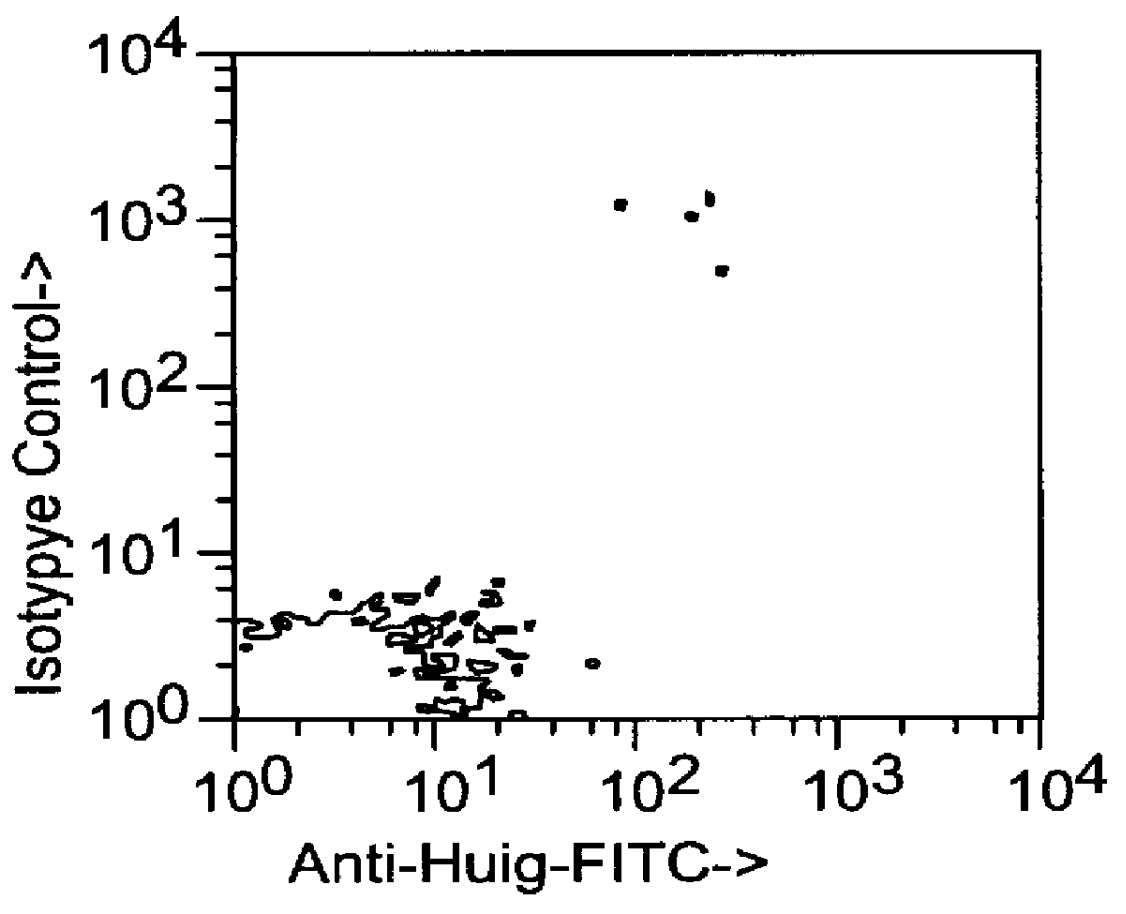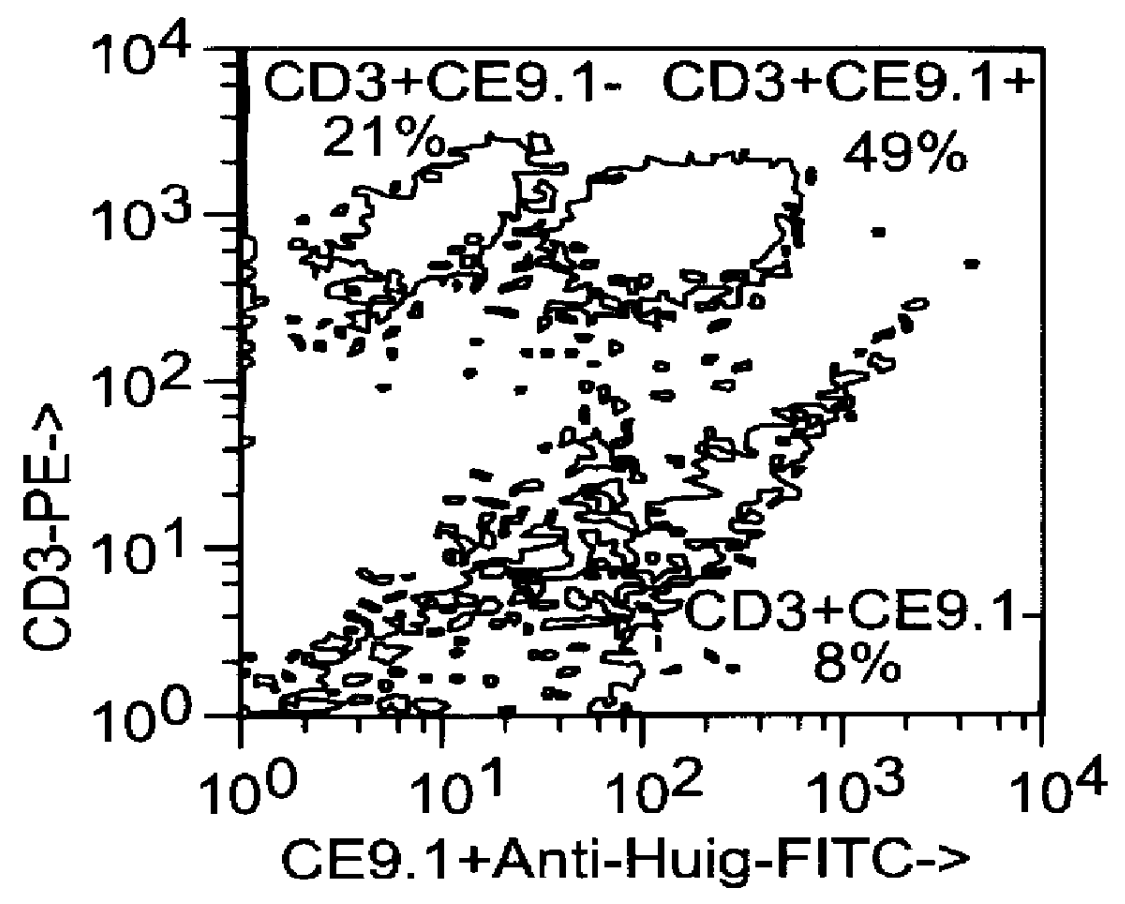Recombinant anti-CD4 antibodies for human therapy
- Summary
- Abstract
- Description
- Claims
- Application Information
AI Technical Summary
Benefits of technology
Problems solved by technology
Method used
Image
Examples
example 2
This example relates to the in vitro functional characterization of CE9.1, including its effects on T cell proliferation and IL-2 production in MLR, its Fc receptor and complement binding properties, and its capacity to mediate ADCC and CDC responses. In addition, the in vivo effects on CD4 receptor mediation and lymphoid subsets in peripheral blood were analyzed. The following were analyzed. The following materials and methods were used in this example. [Anderson et al, "In vitro and in vivo characterization of a primatized mAb to human CD4: mAb causes CD4 receptor modulation but not CD4 T cell depletion in chimpanzees".]
Materials and Methods
Molecular Construction and Expression of PRIMATIZED.TM. Anti-CD4
Variable region immunoglobulin genes were amplified by PCR and cloned from a heterohybridoma derived from a monkey immunized with sCD4, as previously described [Newman, R. A., et al, "Primatization of recombinant antibodies for immunotherapy of human disease: a macaque / human chimer...
example 3
This example describes the genetic construction of the DNA expression vector used in mammalian cells to produce CE9.gamma.4PE which is a macaque / human chimeric anti-CD4 antibody containing a human .gamma.4 isotype incorporating the P and E changes.
Construction of DNA Expression Vector
Human gamma 4 heavy chain gene was isolated by PCR from the cell line TPIT10.4 (obtained from S. Morrison, UCLA) using the 5' IDEC primer # 479 and the 3' IDEC primer # 462 (see FIG. 16) which contained Nhe I and BamH I sites respectively. The entire cloned fragment of the human gamma 4 has been sequenced and found to be identical to that described in Kabat et al (NIH Publication Fifth Edition No. 91-3242, U.S. Dept. of Health and Human Services (1991)) (see FIG. 17). The Nhe I / BamH I fragment was cloned into an expression vector Anex 2. The entire light and heavy chain immunoglobulin genes from this plasmid were moved to another expression plasmid on a Bgl II to Sac I fragment. This plasmid was called ...
example 4
Expression in Chinese Hamster Ovary (CHO) Cells
Integration of plasmid and selection for antibody producing clones
CHO cells (DG44) (Urlaub et al., Som. Cell Mol. Genet., 16:555-566 (1986)) were grown in CHO-S-SFM II media containing (GIBCO / BRL, CHO media), 50 uM Hypoxanthine and 8 uM Thymidine (GIBCO / BRL, CHO media). This media is called CHO media plus HT.
Five electroporations were performed with 4.times.10.sup.6 cells and 5 ug of plasmid DNA [Anti-CD4(.gamma.4(PE), Lambda, OZ-) in NEOSPLA3F] using a BTX 600 electroporation device (BTX, San Diego, Calif.) in 0.4 ml disposable cuvettes. Prior to electroporation the plasmid had been restricted with Pac I which separates the genes expressed in mammalian cells the portion of the plasmid used to grow the plasmid in bacteria. Conditions for electroporation were 230 volts, 400 microfaradays, 13 ohms. Each electroporation was plated into a single 96 well dish (about 40,000 cells / well). Dishes were fed with CHO media+HT containing G418 (Genet...
PUM
| Property | Measurement | Unit |
|---|---|---|
| Molar density | aaaaa | aaaaa |
| Molar density | aaaaa | aaaaa |
| Molar density | aaaaa | aaaaa |
Abstract
Description
Claims
Application Information
 Login to View More
Login to View More - R&D
- Intellectual Property
- Life Sciences
- Materials
- Tech Scout
- Unparalleled Data Quality
- Higher Quality Content
- 60% Fewer Hallucinations
Browse by: Latest US Patents, China's latest patents, Technical Efficacy Thesaurus, Application Domain, Technology Topic, Popular Technical Reports.
© 2025 PatSnap. All rights reserved.Legal|Privacy policy|Modern Slavery Act Transparency Statement|Sitemap|About US| Contact US: help@patsnap.com



